last updated 19 Nov 2023
Contents: Microscopes overview | Glossary
See also Kids-microscopes
Overview:
Note: The numbers here age, price, magnification are general guides not hard-and-fast rules.
Microscopes are one of the most widely used tools in science.
They mignify things from 5 times (5X) to 1,500 times (1,500X)
Analog microscopes that use light and mirrors to magnify objects usually max out at about 1,500x magnification. This is because light wavelengths cause the image to appear unclear at that magnitude of magnification.
Electron microscopes, however, can produce images that exhibit impressive clarity all the way up to 200,000x magnification since electrons have much shorter wavelengths.
Compound Microscopes multiple objective lenses = usually 1 eyepiece
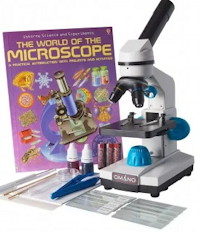 $50-$190
$50-$190
Stereo microscopes Dissecting Microscopes 2 eyepieces - (Lower resolution wider field of view better for large objects - plants, animals, gems, ...) 10x - 50x
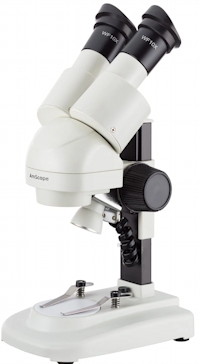 $40 - $300
$40 - $300
Student Microscopes:
ages 13+
Compound 40x - 1000x
Stereo 10x-50x
Magnification Required to see small objects - Resolving Power:
The human eye can recognize two objects if they are not closer than 0.1 mm at a normal viewing distance of 25 cm. This ability to optically separate two objects is called resolving power.
At 40x magnification you will be able to see 5mm. At 100x magnification you will be able to see 2mm. At 400x magnification you will be able to see 0.45mm, or 450 microns. At 1000x magnification you will be able to see 0.180mm, or 180 microns (a human hair).
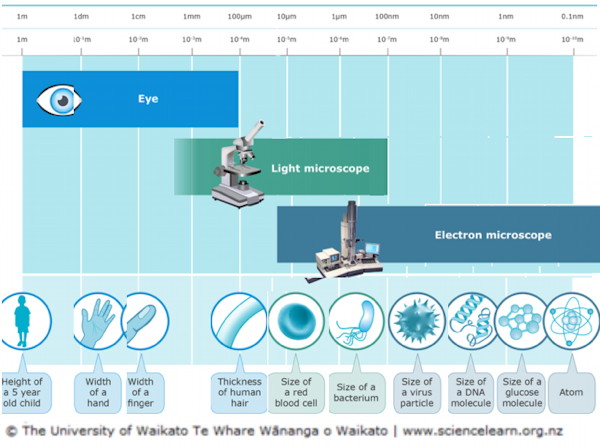
See size in reference
Glossary:
Stereo Microscope
Also known as dissection or dissecting microscopes, or binocular microscopes.
Stereo microscopes have dedicated objective lenses and eyepieces for each eye. The separate optical paths create two axes offset from one another, providing depth perception for a three-dimensional view. This makes stereo scopes ideal for viewing dissection or any larger objects that you may need to manipulate as you observe.
\The working distance of a stereo microscope is from 20 to 150 millimeters.
They have 1 objective lens. Some have a lenses and eyepieces for different magnification.
Compound microscopes
have much higher optical resolutions, so theyre best for viewing or inspecting small specimens requiring very high magnification, including bacteria, plant cells, algae, protozoa, animal cells, chromosomes, and thin slices of organs or tissues. They have a small working distance, which varies from 0.14 to 4 millimeters and is ideal for ultra-thin samples that you can pass light through.
They can have from 2 - 4 lenses which rotate .
- LED microscope - A microscope with LED lights to illuminate the specimen.
- Cordless microscope - battery powered LED (top and bottom LED better)
- Dissecting microscope - Stereo zoom microscope
- Binocular - 2 eyepieces in stereo microscopes and some compound microscopes
- Diopter adjustment on a microscope allows you to adjust the focus for each eye
- Eyepiece (ocular Lens) notation
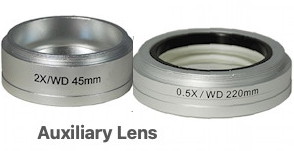

Eyepieces - WF for Wide-Field; UWF for Ultra Wide-Field; SW and SWF for Super Wide-Field; HE for High Eye point; and CF for eyepieces intended for use with CF corrected objectives. Compensating eyepieces are often inscribed with K, C, or comp as well as the magnification.
- Objective Lens at the end:
The working distance (WD) of a microscope is the distance between the front of the objective lens and the surface of the object that is being focused. This distance is measured from the front of the lens to the focal plane.
The WD is the distance at which the sharpest focus is achieved. It applies to both biological and stereo microscopes. The WD can be adjusted using a knob on the microscope.
- Magnification (Enlargement of the object when viewed thru the microscope) is the ocular lens magnification multiplied by the objective lens magnification.
The working distanced of a compound microscope is 0.14 to 4 millimeters
The working distance of a stereo microscope is from 20 to 150 millimeters.
Microscope Anatomy:
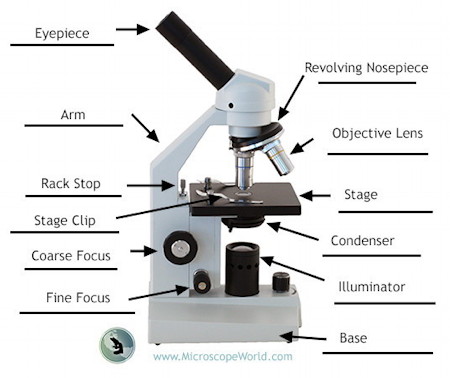
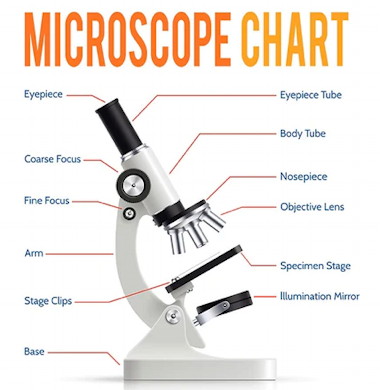
Professional Microscopes
A few examples:
ZEISS Axiolab 5 Phase Fluorescence Beer Wine Microscope $14,000
designed for beer and wine making processes where advanced microscopy techniques are required. Fluorescence is helpful for determining cell viability in beer and wine making samples and is also useful when running a yeast lab. Phase contrast is useful to identify cellular morphology or for detecting contaminants in the cultures.
Motic Swiftline M3 Series Micro/Macro Trinocular Stereo Zoom Microscope. $360:
Professional stereo microscope with a Wide field of view for researchers, gemologists, engravers, collectors and anyone in semiconductor and electronics industries. It is also a perfect microscope for biological laboratory applications that require low heat release.
Compatible with swiftcam digital camera.
SWIFT Digital Professional Trinocular Stereo Zoom Microscope,WF10X Eyepieces,3.5X-90X Magnification,0.7X-4.5X Zoom | amazon is $360
Amazon Rating 4.5
Other Motic Swiftline stereo microscopes | swift optical.
Motic Swiftline M3 Series Micro/Macro Microscope User Manual
Links:
Kids-microscopes
Microscopes | National Geographic
iBioMicroscopy Course
size in reference
Microscope Information & Resources | MicroscopeWorld
Magnification and resolution | Science Learning hub at Pokap Akoranga Ptaiao | sciencelearn.org.nz
The Basics of Microscope Magnification: Everything You Need to Know | AmScope
 $50-$190
$50-$190 $40 - $300
$40 - $300


